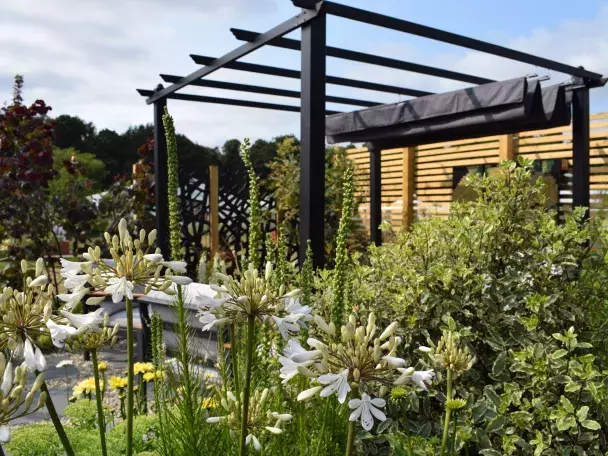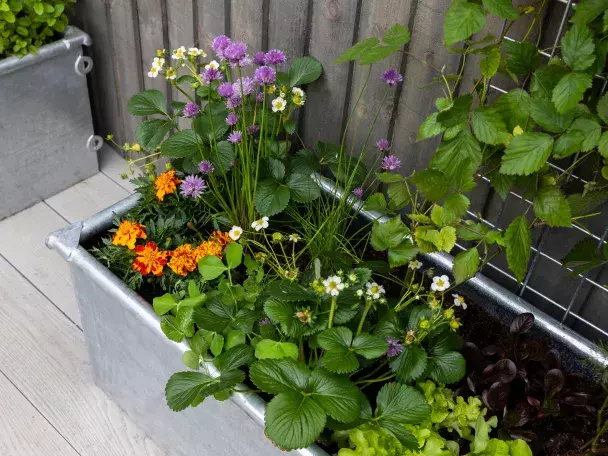Summer is in full swing despite the wettest spring and summer on record. If, like me, you’ve been darting around trying to dodge the downpours—attempting to squeeze in some gardening and, quite frankly, falling short—it can feel a bit disheartening at times. Still, the garden keeps on thriving.

Weeds will grow, so it’s essential to stay on top of them. Removing the weed’s roots is the only way to ensure it won’t return. Also, be sure to remove any flowers on weeds, as these will soon turn into seed heads that can spread across your garden with the next gust of wind.
Plants may be a few weeks behind due to the cool spring, but they’ll catch up soon. With strong winds and heavy rain, it’s important to stake your plants. Ideally, you should get stakes and supports in place while the plants are still young so they can grow through them and conceal the support. If you haven’t had the chance to get outside until now, continue placing your supports gently and guide the plants’ stems and branches through them—or use garden twine to tie stems to upright supports.
With all the excess water, now’s a great time to improve your soil’s structure. By adding horticultural grit and well-rotted manure or homemade compost, you can loosen the soil and allow water to penetrate deeper. This extra humus will also help absorb some of that surplus moisture. Adding a mulch of bark chips and homemade compost acts like a sponge. By keeping an eye on the mulch and soil, you can help your plants thrive and keep their stems healthy.

Our beloved dahlias are growing fast and will be blooming soon. While earwigs can be a nuisance, there’s a simple solution: place a cane next to each dahlia, then set an upturned pot on top of the cane filled with shredded paper. The earwigs will crawl into the paper overnight, and in the morning, you can dispose of them however you see fit. Some dahlias may need the support of a thick bamboo cane or wooden stake, but they’re well worth the effort. As flowers fade, continue to deadhead them to encourage new growth and more blooms. With a little care, dahlias will reward you with armfuls of flowers for your home and plenty more to brighten your garden.
As the soil warms up, it’s also the perfect time to sow delicious vegetables directly into the ground, pots, or containers. Weed the area and remove any large stones. Direct sow carrots, broccoli, and Swiss chard alongside quick-growing crops like lettuce, salad greens, radishes, spring onions, and beets. Early summer is also a great time to direct sow companion flowers such as calendula and nasturtiums. If you missed the window for sowing flowers from seed, there’s still time in early summer to buy young plants or plugs and get them growing.

Fill your containers with fresh herbs and place them just outside the back door for easy access. Be sure to keep up with harvesting your herbs. If you don’t need them right away, chop them up and place them in ice cube trays. Fill the trays with water, and when you’re ready to use them, just drop a cube into your saucepan. This way, you can enjoy fresh herbs year-round.
All spring-flowering plants should be cut back during the summer. Roses that bloom in June and July should be deadheaded regularly to encourage more blooms. Also, apply a liquid fertilizer—like homemade comfrey or tomato feed—around the base of your roses. Sweet peas will be in bloom, but to extend their flowering period, it’s important to keep cutting them and apply a liquid seaweed feed to prevent stress. Pick a few handfuls for indoor arrangements—they’ll fill your home with a delightful fragrance.

All spring-flowering plants should be cut back during the summer. Roses that bloom in June and July should be deadheaded to encourage more blooms. Also, apply a liquid feed—such as homemade comfrey or tomato fertilizer—around the base of the roses. Sweet peas will be blooming, but to prolong the display, it’s essential to keep cutting them and apply a liquid seaweed feed to reduce plant stress. Pick a few handfuls for indoor arrangements—they’ll fill a room with their lovely fragrance.
With all the rain and strong winds, it’s important to check that your fences are upright and secure. Patios should be swept and cleaned to remove algae and mold. Decking—such as Millboard—is easy to maintain. Regular cleaning with mild detergent and water is typically enough. It doesn’t require sanding, staining, or sealing. Of course, the exact amount of cleaning will depend on your deck’s location, but cleaning it twice a year will help keep it in excellent condition.

We all love spending more time outdoors as the temperature rises. Creating a seamless connection between the house and the outside is key to forming an extra “room.” Add furnishings that match your interior décor—perhaps some throws or loose scatter cushions that can be used both indoors and outdoors. If you’re laying a new deck or patio, remember to measure your tables and chairs (with the chairs pulled out) to make sure the space is large enough to accommodate everything.
And finally, don’t forget to sit back, relax in your garden, and take pride in everything you’ve accomplished.

.jpg?crop=yes&w=1500&h=1125&itok=tSz-2IpJ)